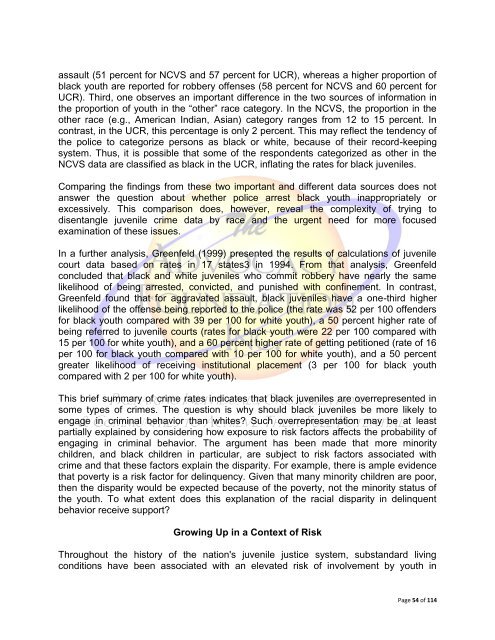African-American Youth in The Juvenile Justice System
African-American Youth in The Juvenile Justice System
African-American Youth in The Juvenile Justice System
You also want an ePaper? Increase the reach of your titles
YUMPU automatically turns print PDFs into web optimized ePapers that Google loves.
assault (51 percent for NCVS and 57 percent for UCR), whereas a higher proportion of<br />
black youth are reported for robbery offenses (58 percent for NCVS and 60 percent for<br />
UCR). Third, one observes an important difference <strong>in</strong> the two sources of <strong>in</strong>formation <strong>in</strong><br />
the proportion of youth <strong>in</strong> the “other” race category. In the NCVS, the proportion <strong>in</strong> the<br />
other race (e.g., <strong>American</strong> Indian, Asian) category ranges from 12 to 15 percent. In<br />
contrast, <strong>in</strong> the UCR, this percentage is only 2 percent. This may reflect the tendency of<br />
the police to categorize persons as black or white, because of their record-keep<strong>in</strong>g<br />
system. Thus, it is possible that some of the respondents categorized as other <strong>in</strong> the<br />
NCVS data are classified as black <strong>in</strong> the UCR, <strong>in</strong>flat<strong>in</strong>g the rates for black juveniles.<br />
Compar<strong>in</strong>g the f<strong>in</strong>d<strong>in</strong>gs from these two important and different data sources does not<br />
answer the question about whether police arrest black youth <strong>in</strong>appropriately or<br />
excessively. This comparison does, however, reveal the complexity of try<strong>in</strong>g to<br />
disentangle juvenile crime data by race and the urgent need for more focused<br />
exam<strong>in</strong>ation of these issues.<br />
In a further analysis, Greenfeld (1999) presented the results of calculations of juvenile<br />
court data based on rates <strong>in</strong> 17 states3 <strong>in</strong> 1994. From that analysis, Greenfeld<br />
concluded that black and white juveniles who commit robbery have nearly the same<br />
likelihood of be<strong>in</strong>g arrested, convicted, and punished with conf<strong>in</strong>ement. In contrast,<br />
Greenfeld found that for aggravated assault, black juveniles have a one-third higher<br />
likelihood of the offense be<strong>in</strong>g reported to the police (the rate was 52 per 100 offenders<br />
for black youth compared with 39 per 100 for white youth), a 50 percent higher rate of<br />
be<strong>in</strong>g referred to juvenile courts (rates for black youth were 22 per 100 compared with<br />
15 per 100 for white youth), and a 60 percent higher rate of gett<strong>in</strong>g petitioned (rate of 16<br />
per 100 for black youth compared with 10 per 100 for white youth), and a 50 percent<br />
greater likelihood of receiv<strong>in</strong>g <strong>in</strong>stitutional placement (3 per 100 for black youth<br />
compared with 2 per 100 for white youth).<br />
This brief summary of crime rates <strong>in</strong>dicates that black juveniles are overrepresented <strong>in</strong><br />
some types of crimes. <strong>The</strong> question is why should black juveniles be more likely to<br />
engage <strong>in</strong> crim<strong>in</strong>al behavior than whites? Such overrepresentation may be at least<br />
partially expla<strong>in</strong>ed by consider<strong>in</strong>g how exposure to risk factors affects the probability of<br />
engag<strong>in</strong>g <strong>in</strong> crim<strong>in</strong>al behavior. <strong>The</strong> argument has been made that more m<strong>in</strong>ority<br />
children, and black children <strong>in</strong> particular, are subject to risk factors associated with<br />
crime and that these factors expla<strong>in</strong> the disparity. For example, there is ample evidence<br />
that poverty is a risk factor for del<strong>in</strong>quency. Given that many m<strong>in</strong>ority children are poor,<br />
then the disparity would be expected because of the poverty, not the m<strong>in</strong>ority status of<br />
the youth. To what extent does this explanation of the racial disparity <strong>in</strong> del<strong>in</strong>quent<br />
behavior receive support?<br />
Grow<strong>in</strong>g Up <strong>in</strong> a Context of Risk<br />
Throughout the history of the nation's juvenile justice system, substandard liv<strong>in</strong>g<br />
conditions have been associated with an elevated risk of <strong>in</strong>volvement by youth <strong>in</strong><br />
Page 54 of 114

















